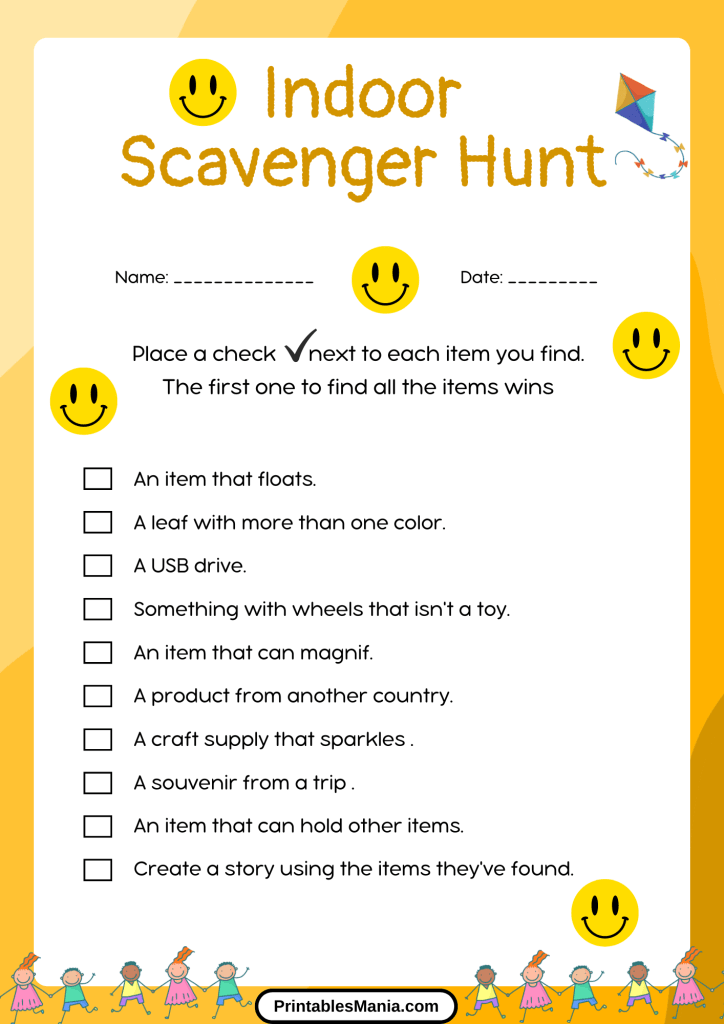An indoor scavenger hunt is a thrilling game perfect for kids of all ages to play inside the house. It involves a list of items that participants need to find within a set time frame. This fun activity can be tailored to fit any space, large or small, and is an excellent way for children to explore their environment creatively and energetically.
How to Play
- Prepare the List: Start by choosing items from our curated lists that suit your indoor environment and the age group of the participants.
- Set the Rules: Decide on the rules, like whether hints are allowed, how much time each participant has, and if there are any off-limit areas.
- Get Ready to Hunt: Once everything is set up, distribute the list to the participants and start the timer.
- Search and Find: Participants will search for the items on their list. The first one to complete the list or the one who finds the most items when the time runs out wins!
- Celebrate: After the hunt, gather everyone to share their finds, discuss the challenges, and celebrate with some treats.
Benefits of Playing
Scavenger hunts are more than just fun. They enhance problem-solving skills, promote physical activity, and encourage observational skills. Plus, they’re a fantastic way to break the routine and inject some excitement into a regular day. Join us in creating an unforgettable adventure right in the comfort of your home!










Reward Ideas
Rewards can significantly enhance the excitement and satisfaction derived from participating in an indoor scavenger hunt. Here are some creative reward ideas that can be easily implemented:
- Certificates of Achievement: Provide personalized certificates to each participant for taking part or for special achievements like ‘Most Items Found’, ‘Best Team Player’, or ‘Most Creative Finder’.
- Small Prizes: Offer small prizes such as stickers, pencils, or small toys. These can be themed to match the scavenger hunt or simply fun items that children enjoy.
- Special Privileges: Rewards could also include special privileges like choosing the next movie for movie night, picking what’s for dinner, or an extra half hour of bedtime stories.
- Craft Activities: Let the winners choose a craft activity for everyone to participate in after the hunt. This not only extends the fun but also rewards the winners with the leadership of the next group activity.
- Books or Puzzles: Encourage ongoing engagement with puzzles, books, or games that are relevant to the scavenger hunt theme or the interests of the children.
- Adventure Tickets: If budget allows, tickets to a local zoo, museum, or indoor playground make exciting rewards that extend the adventure beyond the home.
Educational Tie-ins
Incorporating educational elements into a scavenger hunt can transform it from a simple game into a rich learning experience. Here’s how you can tie educational content into your scavenger hunt:
- Literacy Skills: Use written clues that require reading and comprehension. This could involve riddles, poems, or simple stories where the next clue is embedded within the text.
- Math Challenges: Include challenges that require counting, measuring, or simple arithmetic to solve clues. For example, find an item that weighs the same as three apples, or count the number of blue items in a room to get the next clue.
- Science Exploration: Turn the scavenger hunt into a mini science expedition. For example, ask participants to find items that sink or float, identify materials based on their properties, or observe plant growth.
- History and Culture: Include items that are culturally or historically significant, like an artifact that represents a specific era or a music record from a notable decade. Provide context or stories about these items to deepen the learning.
- Art and Creativity: Encourage creativity by having participants draw one of the items they find or create a simple craft from several items. This could also include composing a short poem or story about an item.
- Environmental Education: Teach children about recycling and sustainability by including items made from recycled materials or that can be recycled. Discuss why recycling is important and how each item can be responsibly disposed of.
By integrating these reward ideas and educational tie-ins, your indoor scavenger hunt can offer both fun and a meaningful, enriching experience that children will remember and learn from.







